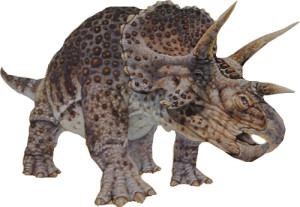We’ve all seen photos and animated videos of the three-horned Triceratops, one of the most popular dinosaurs that the public can recognize. But now scientists are saying that it didn’t really exist, but the recovered bones were those of a juvenile form of a Torosaurus, the three horned dinosaur we haven’t heard of. Apparently, dinosaurs’ skulls can shape-shift.
This discovery comes from a study of the iconic dinosaur triceratops and its close relative torosaurus. Their skulls are markedly different but are actually from the very same species, argue John Scannella and Jack Horner at the Museum of the Rockies in Bozeman, Montana.
Triceratops had three facial horns and a short, thick neck-frill with a saw-toothed edge. Torosaurus also had three horns, though at different angles, and a much longer, thinner, smooth-edged frill with two large holes in it. So it’s not surprising that Othniel Marsh, who discovered both in the late 1800s, considered them to be separate species.
Now Scannella and Horner say that triceratops is merely the juvenile form of torosaurus. As the animal aged, its horns changed shape and orientation and its frill became longer, thinner and less jagged. Finally it became fenestrated, producing the classic torosaurus form (see diagram, right).
This extreme shape-shifting was possible because the bone tissue in the frill and horns stayed immature, spongy and riddled with blood vessels, never fully hardening into solid bone as happens in most animals during early adulthood. The only modern animal known to do anything similar is the cassowary, descended from the dinosaurs, which develops a large spongy crest when its skull is about 80 per cent fully grown.
Shape-shifting continued throughout these dinosaurs’ lives, Scannella says. “Even in the most mature specimens that we’ve examined, there is evidence that the skull was still undergoing dramatic changes at the time of death.”
Even in the most mature skulls, there is evidence that they were undergoing dramatic changes
Scannella and Horner examined 29 triceratops skulls and nine torosaurus skulls, mostly from the late-Cretaceous Hell Creek formation in Montana. The triceratops skulls were between 0.5 and 2 metres long. By counting growth lines in the bones, not unlike tree rings, they have shown clearly that the skulls come from animals of different ages, from juveniles to young adults. Torosaurus fossils are much rarer, 2 to 3 metres long and, crucially, only adult specimens have ever been found.
The duo say there is a clear transition from triceratops into torosaurus as the animals grow older. For example, the oldest specimens of triceratops show a marked thinning of the bone where torosaurus has holes, suggesting they are in the process of becoming fenestrated (Journal of Vertebrate Paleontology, vol 30, p 1157).
The finding has implications for the supposed defensive function of the triceratops’ frill. “If I was a triceratops I wouldn’t want anything too damaging to happen to my frill, as it had numerous large blood vessels running over the surface,” says Scannella. “I don’t imagine holding up a thin bony shield that can gush blood would be a very effective means of defence.”
Instead it is likely that the headgear was a display to signal an individual’s maturity to other members of the species. Differences between the sexes is another possibility but less likely, says Scannella.
It was already known that triceratops skulls changed throughout their development, but not that the final result was a torosaurus. Torosaurus will now be abolished as a species and specimens reassigned to Triceratops, says Horner.
Triceratops isn’t the only shape-shifter. Last year, Horner and Mark Goodwin of the University of California, Berkeley, claimed something similar for another iconic Hell Creek dinosaur, the dome-headed pachycephalosaurus, perhaps best known for headbutting jeeps in Jurassic Park 2.
Two similar dinosaurs, classified as Dracorex and Stygimoloch, are also known from Hell Creek. Horner and Goodwin say that they are not separate species but juveniles of pachycephalosaurus (PLoS One, vol 4, p e7676). If so, this is an even more extreme case of shape-shifting than triceratops, with the animal growing horns and then re-absorbing them into its skull as it ages (see diagram).
Soft in the head
Horner says this makes it unlikely that pachycephalosaurus engaged in headbutting as it, too, retained spongy, immature bone throughout adulthood. As with the frill of triceratops, its dome was probably used for display.
On top of that, a dinosaur called Nanotyrannus has been tentatively reclassified as a juvenile form of Tyrannosaurus rex.
Taken together, the “loss” of four species from the Hell Creek formation reveals that the dinosaurs that lived there up until 65 million years ago were not as diverse as previously thought. Triceratops and torosaurus have long been regarded as the last survivors of the horned dinosaurs, a large group that appeared in the Jurassic and reached its heyday about 80 million years ago. Now it seems that only one species made it through to the end of the Cretaceous. This could be evidence to support a disputed theory that dinosaur diversity was in decline long before an asteroid impact wiped them out.
Both Scannella and Horner say it is possible that other dinosaur species from Hell Creek will turn out to be juvenile forms, and add that the same thing is probably true of dinosaurs from other locations and times. “Juvenile dinosaurs were not just miniature versions of adults – they looked very different and could easily be mistaken for distinct species,” says Scannella.
The idea that dinosaurs’ skulls changed radically as they aged was first proposed in the 1970s, but it was difficult to test because dinosaur remains are usually so scarce and so it never gained wide acceptance.
Scannella and Horner were able to make a strong case because triceratops is not scarce. “It is hard to walk out into the Hell Creek formation and not stumble upon a triceratops weathering out of a hillside,” says Scannella. In the past decade, 47 complete or partial skulls have been found there.
“The work is startling, not least because triceratops and torosaurus have been so heavily studied for over 100 years,” says Mike Benton, a vertebrate palaeontologist at the University of Bristol, UK. “To suggest they are different growth stages of one form is a remarkable observation, and may well prove highly controversial, but the case is persuasive. It has always been difficult to distinguish the two.”
Goodwin says the recent work is convincing and will mark a major shift in the field: palaeontologists must now factor in extreme changes in skull shape or risk misunderstanding evolutionary relationships and overestimating dinosaur diversity. Ignore physical development in dinosaur palaeontology “at your peril”, he warns.
Source: New Scientist.
[ttjad]




Hello, fellow readers. Please understand that this article totally gets the story wrong. Triceratops isn't going anywhere; if anything, it will be Torosaurus that ceases to be used as a name. And this is still a debated issue among paleontologists. Please read this post for much more accurate information:
http://blogs.smithsonianmag.com/dinosaur/2010/0…
Pingback: World Wide News Flash
To everyone here: David Orr is right Even though Triceratops turns out to be a young adult form of Torosaurus (which I doubt), it is the name Torosaurus, NOT Triceratops that will go away since Triceratops was named 1st. That’s why the name Apatosaurus is valid while Brontosaurus is not. However, I think Jack Horner is going a little bit too far on this. Firstly, postcranial material of Torosaurus shows that Torosaurus is 7.6 meters long, smaller than the 9 meter long Triceratops (I wonder whether John Scannella and Jack Horner even knows how small Torosaurus actually is compared to Triceratops). One of the only animals (if not the only) which shrink as they grow up is the paradoxical frog, and dinosaur species (eg. Allosaurus, Triceratops’s relatives Protoceratops and Centrosaurus) which fossils of nearly all ages found indicates that NO dinosaur grows up like that. Not only that, Horner and Scanella’s theory suggest that the solid frill in Triceratops grew the 2 holes on it’s frill as Triceratops mature. If that’s the case, why would they grow a solid frill in the 1st place if they would grow 2 holes on it’s frill in later life? I also think that Mark Goodwin and Jack Horner’s theories on the Pachycephalosaurs are just as ridiculous. For Stygimoloch, it is highly unlikely that it grew spikes behind it’s dome if they were to shrink in later life as that would be a waste. As for Dracorex, this webpage proves that like Stygimoloch, Dracorex IS NOT a Pachycephalosaurus: http://www.thedracorex.com/dracorex-faq.html
Pingback: 1flustered